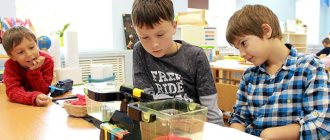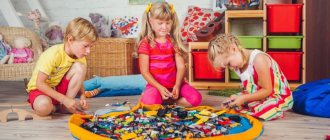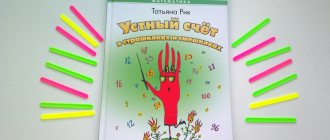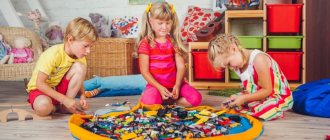There is one wonderful Japanese proverb that Nikitin followed. It goes like this: “Tell me and I’ll forget.” Show me and I will remember. Let me do it myself and I’ll understand.”
Who are the Nikitins and how did they advise raising children? You will learn about the principles of education, the principles of using educational games, and the games themselves using the Nikitins’ method from the article “The Nikitins’ Methodology and Educational Games.”
Physical development of a child according to Nikitin
Childbirth: what needs to be done
All doctors, psychologists, teachers express a common opinion - the health of the child largely depends on how the birth went. Lena and Boris Nikitin, parents of seven children, wrote a book: “A request to the doctors and nurses of the maternity hospital,” the contents of which are still relevant for many maternity hospitals.
Let's consider the key points of the Nikitins' book:
- Lack of anesthesia during childbirth. The fact is that anesthesia is harmful for a woman in labor, and even more harmful for a newborn child. Anesthesia cannot drown out the pain of labor. Childbirth, if possible, if there is no pathology, should take place naturally.
- The umbilical cord should not be clamped or cut immediately after birth. As long as the umbilical cord transmits blood to the baby, he should receive it. In order to restore strength after childbirth and not develop hypoxia.
- As soon as the baby is born, put him to the breast . The umbilical cord has not yet been cut. Sucking and closeness to the mother will calm the baby and give him a feeling of protection. For the mother, this is also beneficial and natural, since feeding the baby provokes contraction of the uterus, the release of blood accumulated in it after childbirth. And, most importantly, it stimulates the formation of breast milk.
- After childbirth, a newborn child should not be separated from its mother . Mother and baby should have a warm relationship, affection, unconditional love, which is necessary for every person throughout life. And this family attachment begins from the first days spent with mother.
- Feeding at the baby's first request. You should not impose your feeding regime on your child. If he wants to eat, let him suckle, even at night. All living things on earth have no feeding regimes. A calm and well-fed child is healthy development.
- Do not keep your baby in diapers all the time . Tight swaddling prevents the baby from moving freely. The world around him should awaken interest and curiosity in him, which will form educational motivation in the future.
- Strengthen the child from birth. Air and sun baths, water procedures should begin from the moment of birth.
Independence
The Nikitins approached developing independence in children seriously and tried to shape it from the very first years of life.
“We tried not to do for the baby what he could do himself, not to think and decide for him if he could think of it and decide for himself. In general, in any children’s activities, we try to encourage creativity, not to impose our opinions, much less decisions, and we are not in a rush to necessarily prevent a mistake or immediately point it out. We were simply interested in the children, and we never remained indifferent to what and how they do, what they do. It was not control, not tracking, not guardianship, not lessons with testing, but a completely sincere interest in the lives of the children, in their various vigorous activities.”
But this same seriousness of approach (like any dogma in development methods) also produced sad results:
“When our first-born was a year and a half old, we taught him independence in this way: if he found himself in a difficult situation (fell or couldn’t reach something), we “didn’t pay attention to it”, didn’t help him, despite all his tears and screams - let him learn to get out of difficulties. And they achieved success: the baby himself got out of the difficulty. But, without knowing it, we taught the baby... not to take into account the others. And not only this.
When our second son grew up, we did the same. And then one day the youngest is crying from bruises and fright, and his three-year-old brother does not even look in his direction - just like us adults. There was simply indifference, indifference to my brother’s tears. This gave me an unpleasant shock. It was then that I looked at myself, at our “educational measure” from the outside and understood why it sometimes irritates others. Sometimes, for a simple mistake, we “educate” the child for a long time, saying: “I don’t need you like that!” He seeks our understanding and help, but for a simple mistake he receives the most severe punishment: his mother abandoned him. He protested as best he could, and I... didn’t even try to understand him, I followed some established rules in my actions, and not from the child and his condition.”
Independence in their family was manifested in everything, from helping with household chores and self-care (at the first ability to do this), to independent knowledge of the world and development.
Children independently studied household items and their responsibilities for providing for themselves, for example, at two years old they could already fold an adult cot. They helped prepare dinner and do chores around the house. The Nikitins lived in the countryside, so in addition to cleaning, they also had to carry water, chop wood, finish building the house, etc. Therefore, they had their own workshop where children could freely use adult objects:
“In our workshop room you can cut, glue, sculpt, saw, hammer nails, chop, prick, drill, sharpen.”
Studying the world independently meant that the child could do almost anything, except for very dangerous things. If he could easily get burned, he was allowed to do so. If you wanted to taste the earth, that was also not prohibited. The Nikitins followed the position that a child should experience danger and peace in a relatively safe environment. Then he will be able to learn more about it and better prepare for them, which will protect his life in the future.
Since there were many children in the family, the older children took on part of the development and upbringing of the younger children. After all, as you know, the eldest child in a family, even of two children, often takes on the role of a source of development for his younger brother or sister. Although such responsibilities do not always contribute to the development of an older child.
“We could leave them at home alone (with the 6-7-year-old eldest) for three or four hours and knew that nothing would happen. We could easily send a seven-year-old to Moscow (train, metro) or an eleven-year-old to Gorky (he bought his own ticket, traveled without any supervision from a conductor or any adults).”
Hardening children according to the Nikitins' method
Basic principles of hardening according to the Nikitin method:
- The first physical training begins in utero. During a normal pregnancy, the mother should actively move and engage in physical exercises.
- Children should not be overwrapped or overheated . Try to wear only light clothing while awake. Especially in the warm season: a T-shirt and shorts are enough.
- The room temperature should be no more than 18 degrees . This allows you to keep the child’s body in good shape, which is also a kind of exercise.
- Early air baths. Newborn children in the Nikitin family took air baths every day. And when the child was two months old, the child was taken out into the cold for a few seconds every day. I must say that the children really liked these procedures and in the future they never got sick!
- Dipping a child in cold water from the first days of life . Nikitins advise immersing a newborn baby in cold water with his head. This triggers a very important mechanism of thermoregulation of the body.
- Walk barefoot more. Cold feet of a child are normal! The child should walk barefoot all day and only before going to bed should the feet be washed and warmed up so that the child can relax and fall asleep.
- Physical exercise . The Nikitins recommend that parents do simple physical exercises with their newborn children. Especially those that reinforce unconditioned reflexes. For older children, the Nikitins developed a system of sports corners and equipment.
- Food restriction . The Nikitins are convinced that excessive overeating of a child is more harmful than mild hunger. Don't overfeed your children and they will always have an excellent appetite.
- Lack of daily routine . The Nikitins believe that the regime overtires the baby. The more “obligations”, the less interest. Children should exercise as much as they want, often changing between active (physical) and sedentary (intellectual) activities.
- Freedom to move . As soon as the child begins to crawl, give him complete freedom of movement. But for this you will have to prepare the apartment (secure it). Strollers, walkers, jumpers and playpens are prohibited! Allow your child to play with more than just toys. Introduce your baby to kitchen items, tools, and appliances.
- Combating a sterile environment. There is no need to isolate children from the world. They need information! Let them crawl, touch and even put in their mouth. This knowledge is irreplaceable. Your task is to clean, within reason, if you have a small child at home.
Nikitin's intellectual games
“Tell me and I will forget.
Show me and I will remember.Let me do it myself and I’ll understand.”
Nikitin developed educational games for children of any age. They develop a child’s attention, logic, memory, imagination, creativity, patience and perseverance. For a child to understand how to play, a parent needs a personal example, and then the child plays on his own, without anyone else’s participation.
Features of Nikitin's intellectual games:
- Nikitin's educational games include various puzzles, cubes, construction sets, tables and logical tasks.
- The tasks have different levels of difficulty, both for young children and for high school students.
- You need to play mind games from simple to complex.
- The tasks the child performs are presented in the form of visual teaching material. The correctness of the solution can be verified visually.
- You cannot demand that a child solve this or that problem. The desire of the child himself is primary.
- Almost all of Nikitin’s games assume that you can come up with your own problems and solutions to them.
- An adult should not tell a child. He must think for himself.
- Parents should praise their child for successfully completed tasks, motivating them to continue playing with games.
- If your child gets tired, end the lesson immediately. It’s better to stop on a good note so that the desire to play arises again.
Boris Nikitin described his educational games in the book “Intellectual Games”. Many of Nikitin's intellectual games aids can be made with your own hands. Or you can buy ready-made Nikitin games and manuals.
Bibliography
The Nikitins' books began to be published in the USSR.
B.P. Nikitin
- Creativity steps or educational games. — 1976, 1989, 1990, 1991.
- Educational games. — 1981, 1985.
- Letters to the Murashkovskys. - 1985-87.
- Hypothesis of the emergence and development of creative abilities. — 1985 (unpublished).
- We, our children and grandchildren. — 1989.
- The first lessons of natural education or Childhood without illnesses. — 1990, 1996.
- Our lessons. — 1992.
- The first year is the first day. — 1994.
- Mind games. — 1994, 1998, 2009.
- How to measure a child's development level. — 1997.
- A healthy childhood without drugs or vaccinations. — 2001.
- Chaikovsky. Old and new. — 2001.
L.A. Nikitina
- Father's house. — 1982.
- I'm learning to be a mother. — 1983, 2002.
- Mom or kindergarten. — 1990.
- Confession. — 1991.
- Parents of the 21st century. — 1998.
L. and B. Nikitin
- Are we right? - 1963, 1965.
- First day, first year. — 1978.
- We and our children. — 1979.
- We, our children and grandchildren. — 1989, 1997.
- Health reserves for our children. — 1990.
- Our lessons. — 1992.
Game "Fold the pattern"
The set contains 16 cubes with multi-colored edges. The game develops basic math skills. You can start playing it as early as 1.5 years old.
- Look at the cubes with your child, learn the colors, count their number. This game is for the little ones.
- Show your child that you can build paths from blocks. Wait until the child wants to make the path himself. First, a path of one color (yellow for the “bunny”, and red for the “bunny”). At the same time, we pronounce and fix the name of the color.
- When the child learns to build one-color paths, show how to build multi-colored ones. Here you can study the pattern and sequence: “Look at my path. What did you notice? - Yes, the cubes are blue, yellow, blue, yellow, and which one is next? Continue the path. If you want, come up with your own colorful path for your little fox.”
- After these games, it's time to make patterns from the cubes. First, like my mother’s, then like Nikitin’s manual. Later you can come up with patterns yourself.
Game "Fold the square"
This game consists of colorful squares cut into pieces of different shapes.
This game has three difficulty levels.
| Difficulty levels | I | II | III |
| Number of square components | 2-3 | 3-5 | 4-7 |
| Recommended age (years) | 3-4 | 4-5 | 6-7 |
When playing with your child, do not forget to name the shapes that make up the squares: triangle, trapezoid, etc. You can count how many angles and sides there are. Also called the color of the figure. Pay attention to the child that, for example, triangles come in different sizes and shapes. Here you can also introduce the concepts of “whole” and “part”.
The game develops imagination, logical thinking, fine motor skills, as well as imagination and combinatorial abilities of children.
Role of parents
For parents, education according to Nikitin is associated with enormous dedication and a conscious approach. Their role in this system of education, as part of the pedagogy of cooperation, should be reduced to mentoring, intelligent observation, and the creation of a developing and learning environment from everyday life that will push the child to self-development.
But you can’t go to extremes - don’t organize children (it takes away independence) and don’t let them take their course (except to feed, drink and put them to sleep), because this leads to developmental delays.
Game "Fractions"
The game consists of three plywood boards with 4 circles each. They are all the same in size, but different in color. The first circle is solid, the second is divided into two identical parts, the third into three parts, and so on, up to 12 parts.
First, the first plywood with four circles is introduced into the game. The first thing you can do is say the colors, count the pieces, and compare their sizes.
What to do next with this?
- Invite the child to put pieces of the same color into separate piles.
- Ask the child to make circles of the same color from the resulting piles.
- Explain to the child how the names of one part of the circles are obtained (1/2, 1/3, ¼, 1/5, etc.)
- Play the game: put one piece of different color in a row in ascending order.
- Invite your child to experimentally find out which part is greater than 1/3 or ½. How can this be checked?
- Ask: How many quarters fit on one half? What about sixth parts? Eighth?
- What parts will fit into 1/3?
- How to make a whole circle (two-color, three-color, etc.) from parts of different colors?
- How many whole multi-colored circles can you add together? Etc.
Game "Cubes for everyone"
The game develops spatial thinking abilities, helps to master graphic literacy, and understand drawings before school.
You begin your classes by showing your child a drawing task and asking them to build a model of the drawing using cubes. Having successfully constructed one, move on to the next more complex drawing.
The child needs to choose the right ones from all the figures and place them correctly in the model.
Creative work begins when the child comes up with his own models and uses them to draw a drawing task for adults.
Game "Unicube"
These universal blocks are for children from 2 to 15 years old. They develop spatial thinking, teach clarity, attentiveness, precision, accuracy.
All 27 cubes are different, although only three colors are used to color them. First, parents ask the child to find a cube with two sides of the same color. Then build a “tower”, “house”, “ladder”.
The tasks in Unicube are difficult; you cannot give too many of them at once. Most often, one task is enough, less often two or three, depending on the child’s abilities.
Children are given tasks either through drawings or orally. It is necessary to gradually lead the child to understand tasks well both orally and in the form of drawings.
All mental and construction work should be carried out by the child independently, without adult intervention. The adult’s task is to rejoice at the successful completion of the task and praise the child for his efforts. If you fail, you are upset, but you believe that tomorrow or in a week the child will definitely succeed.
How to play Nikitin's games
And in conclusion - a few general rules for all Nikitin’s intellectual games.
- Games should not be freely available to the child; take them out only when the baby is in the mood and wants to play them.
- Don’t be upset if your child fails to complete the task the first time - perhaps he is not yet mature enough and will succeed later.
- The child should retain the feeling of being “underplayed” and not “overplayed,” so finish the game before he gets tired.
- Get creative with your games. Together with your children, come up with new types of patterns, drawings, and game options.
- An adult should not perform a task for a child, point out mistakes or give hints. You can only push the child and help him find the right solution on his own.
Bottom line
- The methodology is an educational system, and not just a set of exercises.
- Sometimes she is humanistic and the child is an individual with his own feelings. Sometimes she can be cruel, for the sake of the future good (later the Nikitins realized this and softened their methods).
- An independent person is created from a child. It also encourages curiosity. The child independently explores the world, and does not simply assimilate what the adult says or shows.
- Health and physical activity are important.
- There is practically no artistic side of development in the methodology.
Progressio’s development principles largely overlap with the Nikitins’ methodology, smoothing out all the controversial aspects for which it is criticized.
To what extent does the Nikitin methodology correspond to modern child development, within the framework of “21st Century Skills”?
Pros and cons of the Nikitin methods
The “advantages” of the Nikitins’ technique are:
- The child develops well physically, gets sick little, and is hardened.
- A child early learns to think logically: to generalize, highlight the main properties, draw conclusions and apply them in practice. Able to apply acquired knowledge in further games.
- Development of visual, auditory, motor memory;
- Development of interest, curiosity and learning motivation;
- Development of independence;
- Development of creativity, creative imagination
- The technique well prepares the basis for the study of exact sciences.
«Disadvantages of the Nikitins’ technique:
- The Nikitins' method needs to be supplemented with other developmental programs, since it does not contain games that teach reading or preparation for writing.
- Hardening methods are considered too radical; not all parents will follow this example. It will be necessary to obtain recommendations from a pediatrician.
- Not everyone will like the spartan living conditions and malnutrition.
- The Nikitins in their education system do not provide for children's role-playing games at all. The Nikitins’ child should not play with cars, dolls, shops, “war games” and “mothers and daughters”. From early childhood he must be accustomed to work and self-service. Must be able to manage a household. But he just doesn’t know how to play.
If the Nikitins’ methodology is perceived as a good tool for the development of a child’s logic, mathematical skills, and physical development and is supplemented with other good tools for more comprehensive development, then this will be an excellent option for parents, teachers and psychologists. This is what Elena Danilova describes in her book “A New Look at the Nikitins’ Games.” It complements and enriches the tasks for Nikitin’s games and helps parents look at his games a little differently.
Nikitins
Boris Pavlovich Nikitin (1916-1999) and Elena Alekseevna Nikitina (1930-) raised seven children according to their own, non-traditional education system (from which the entire village of Bolshevo near Moscow, where the Nikitin family lived, was shocked). People first started talking about them in the late 50s of the 20th century. Boris and Elena are considered Russian innovative teachers; their educational methods are still used today. It was the Nikitins who laid the foundations of parental pedagogy in the 1960-1970s; they were the first to talk about the need for early development.









